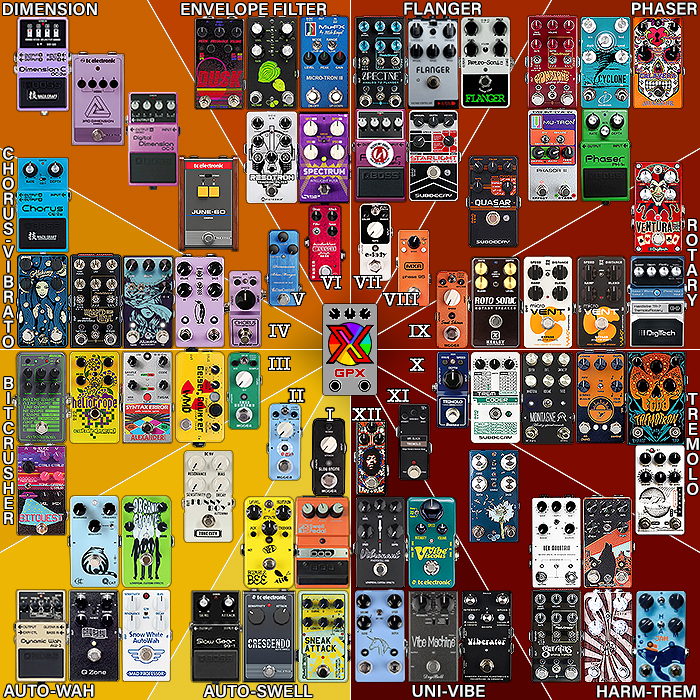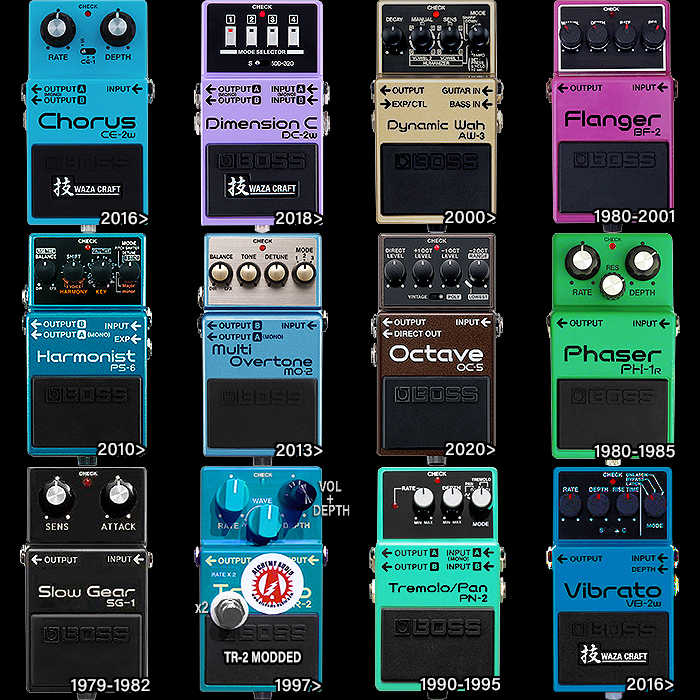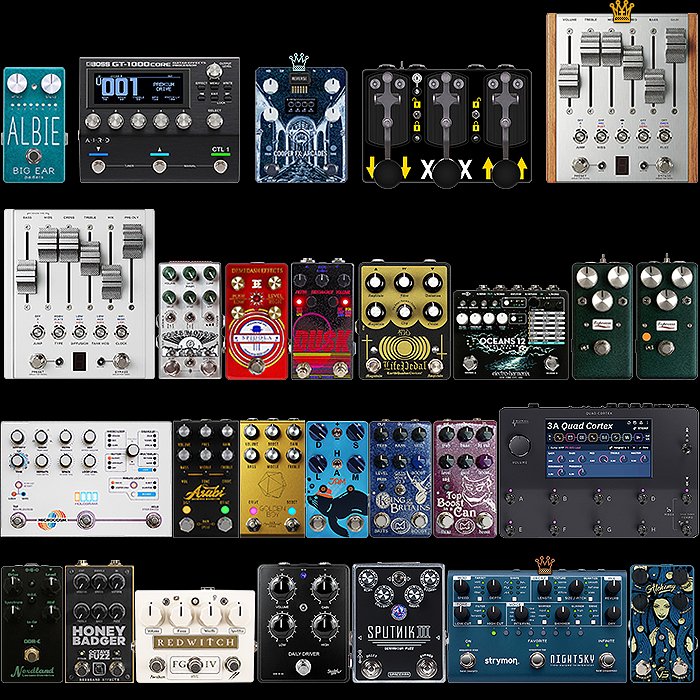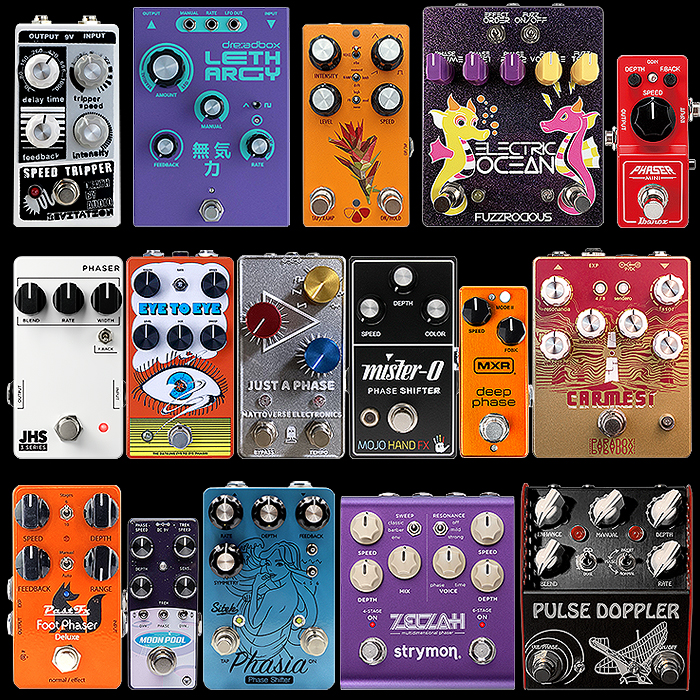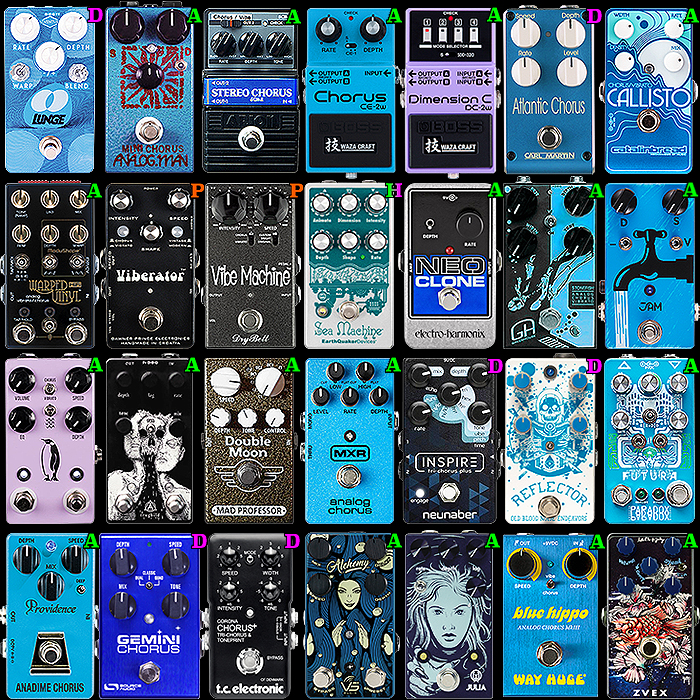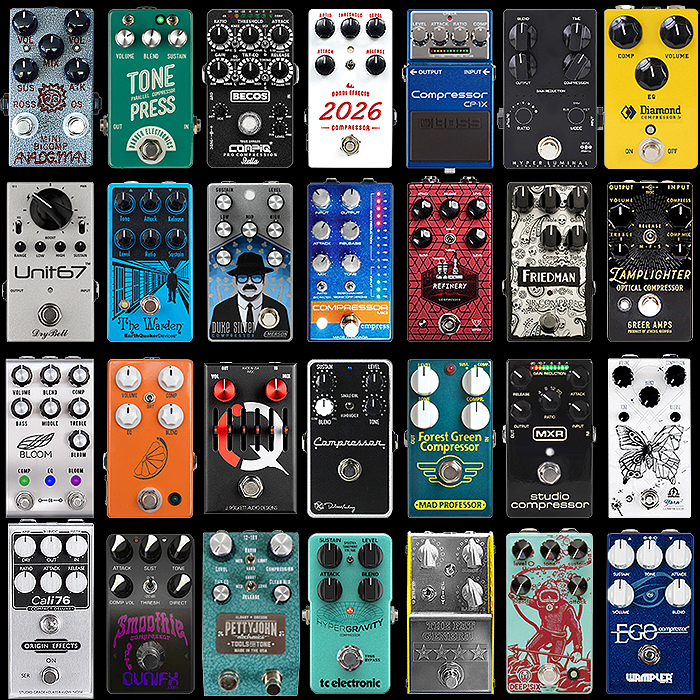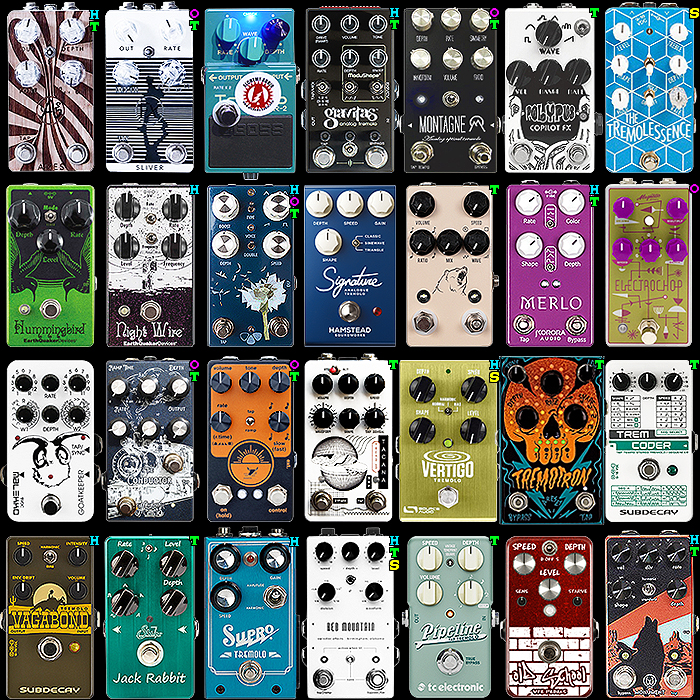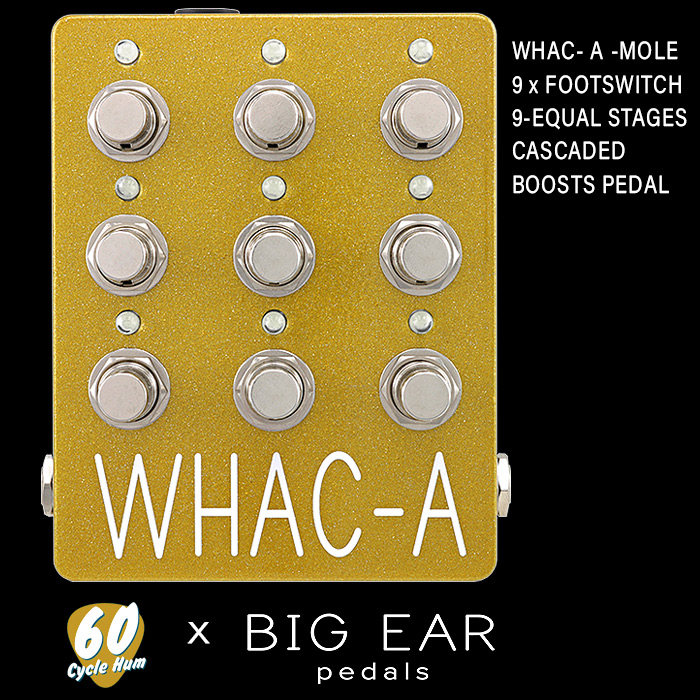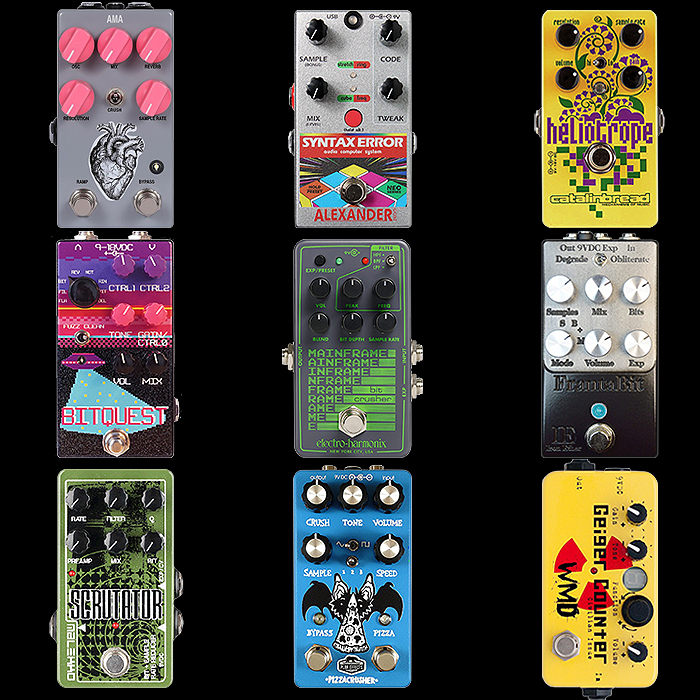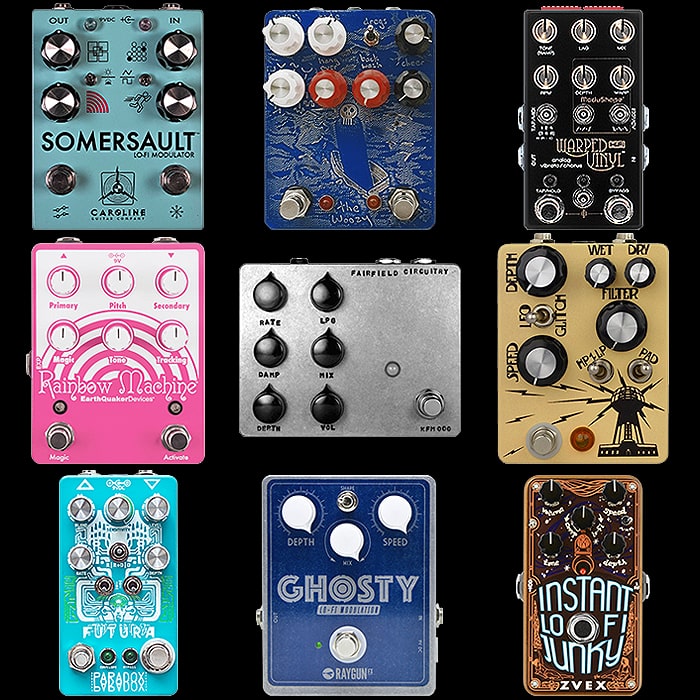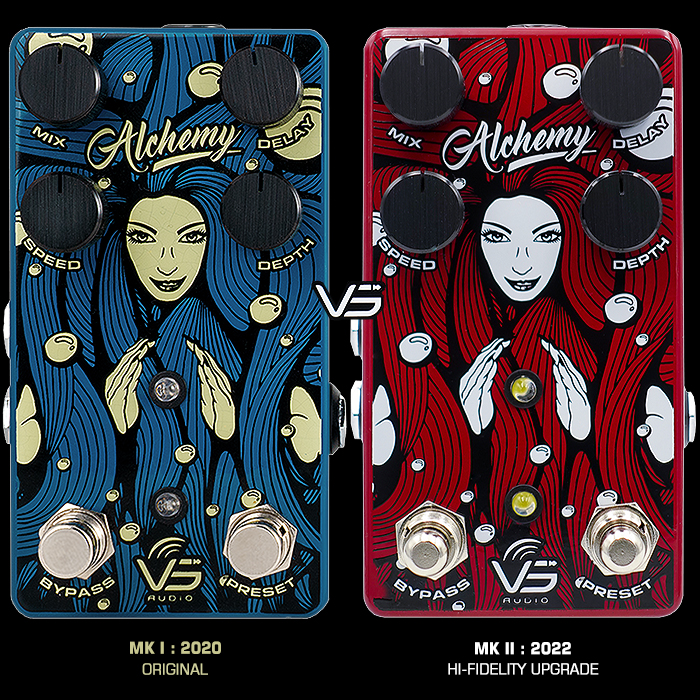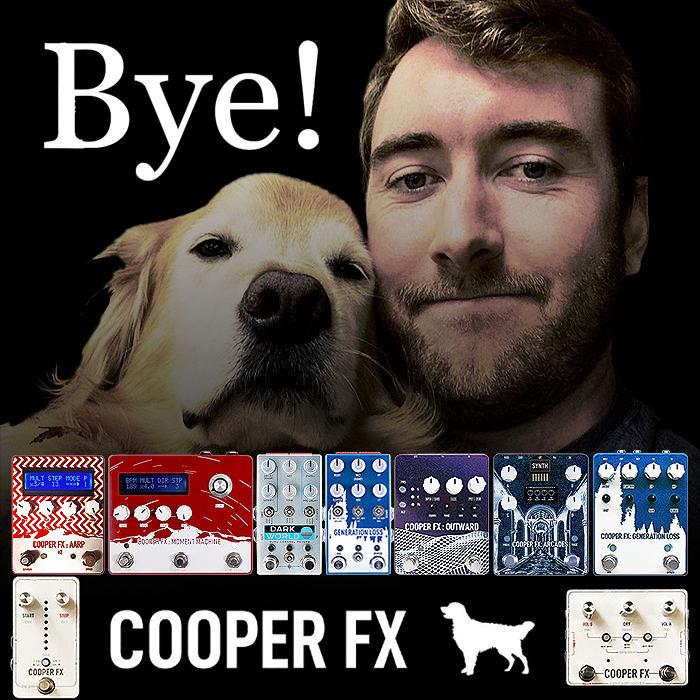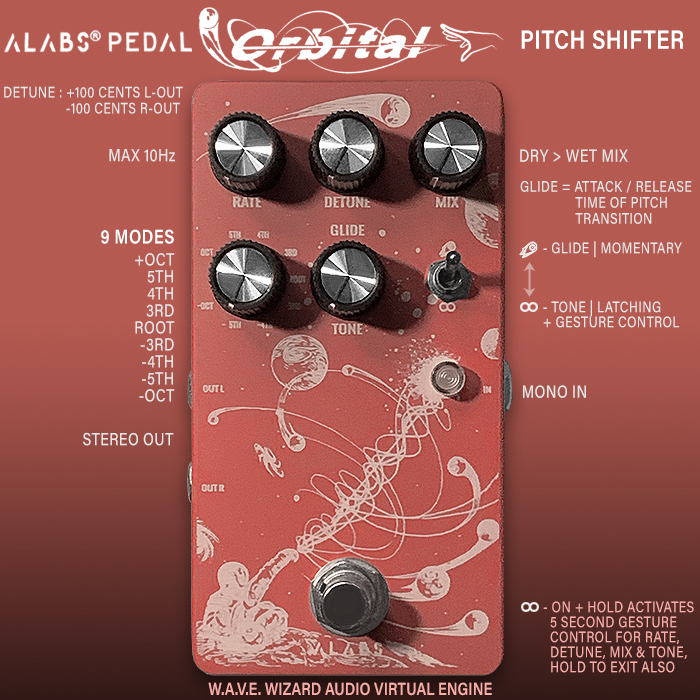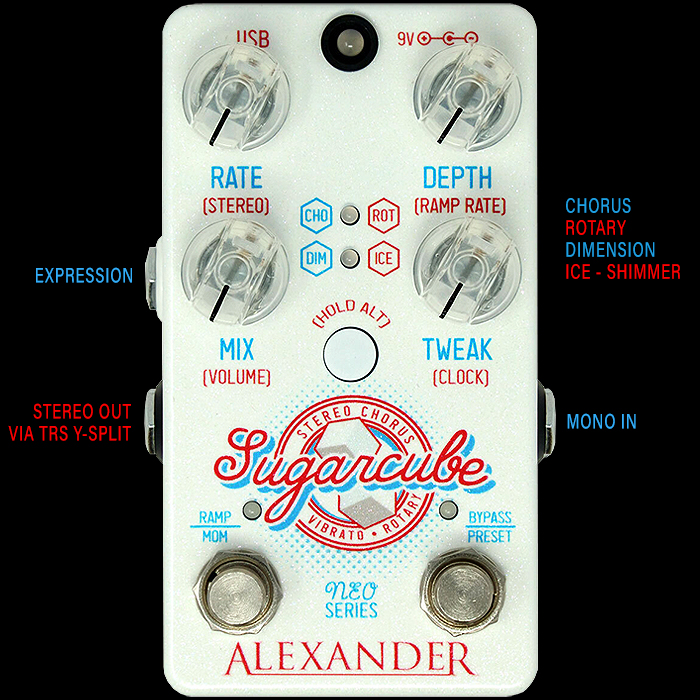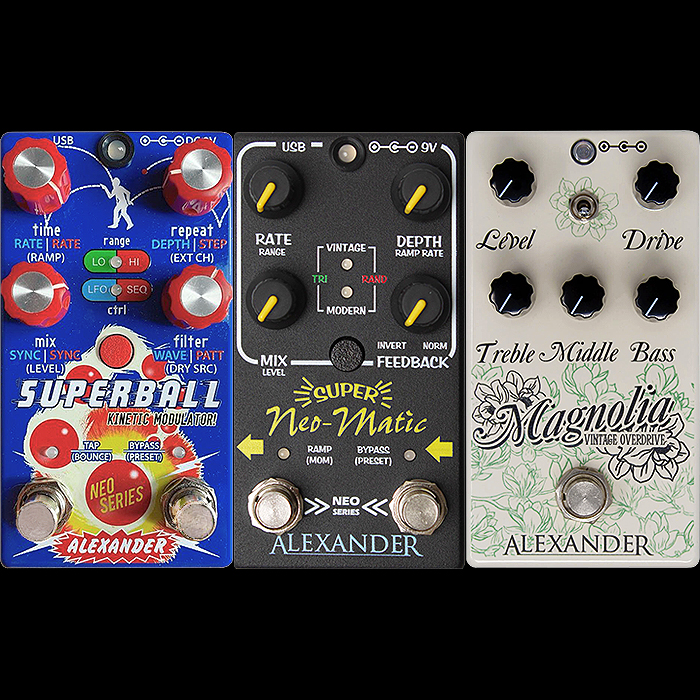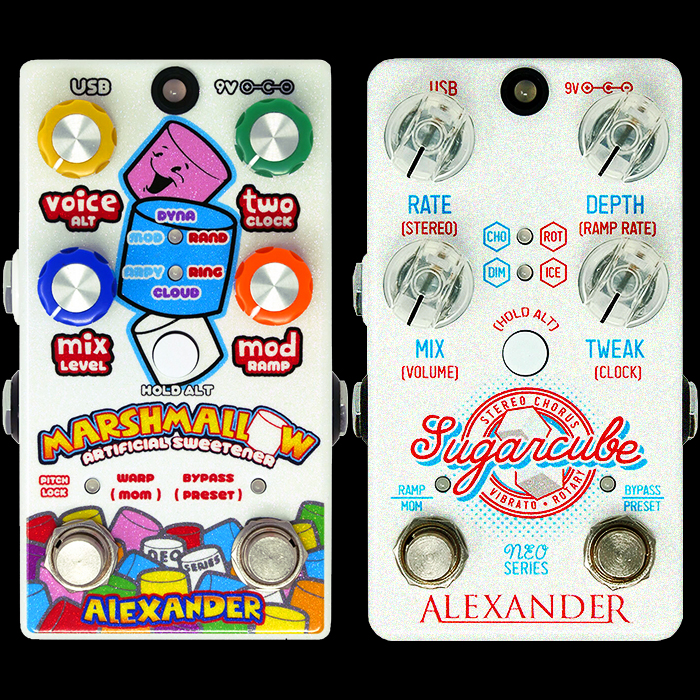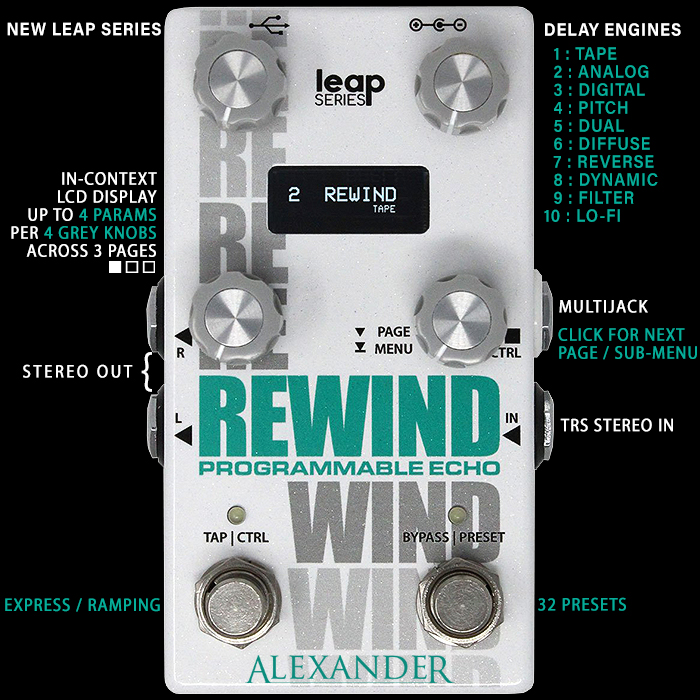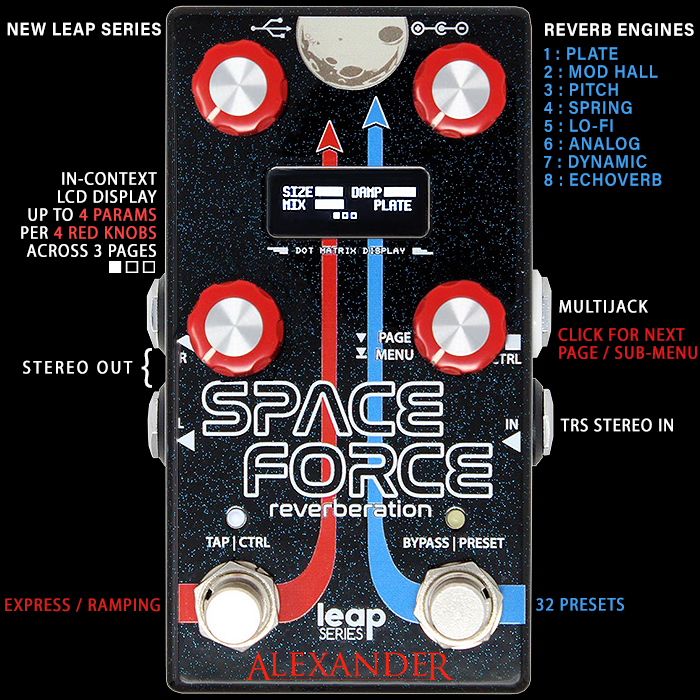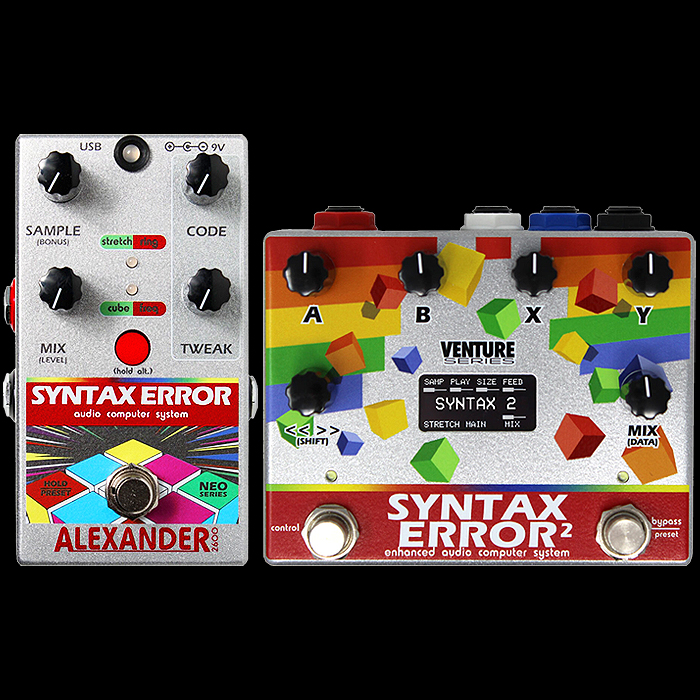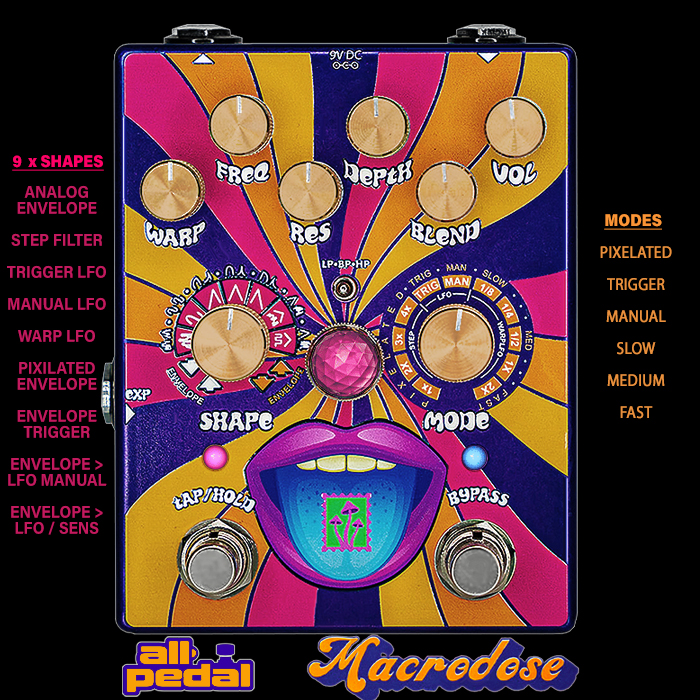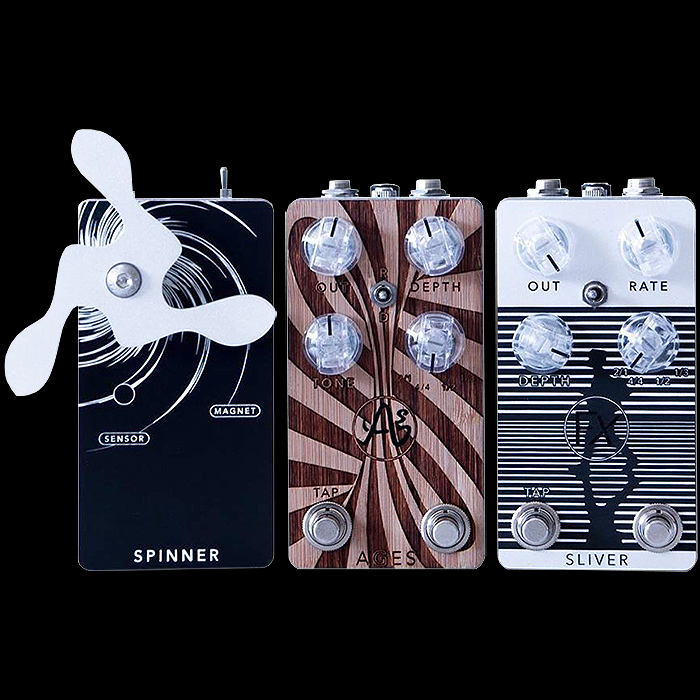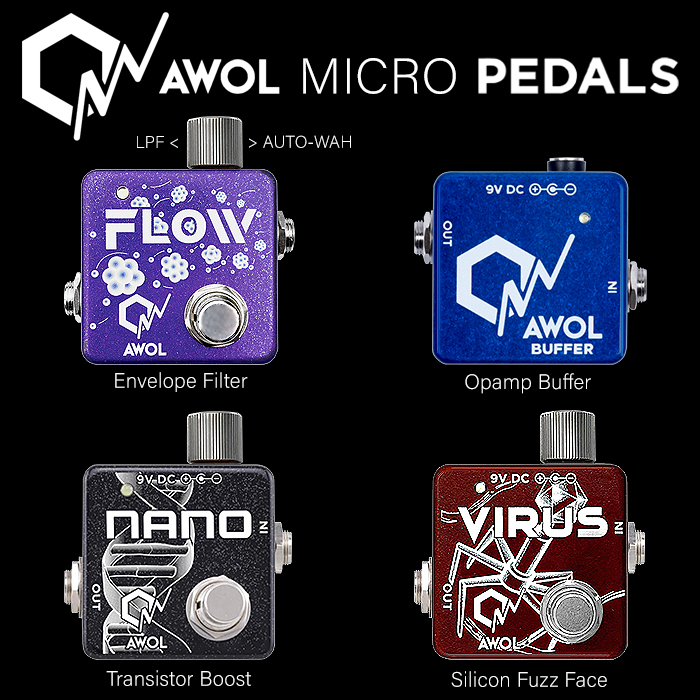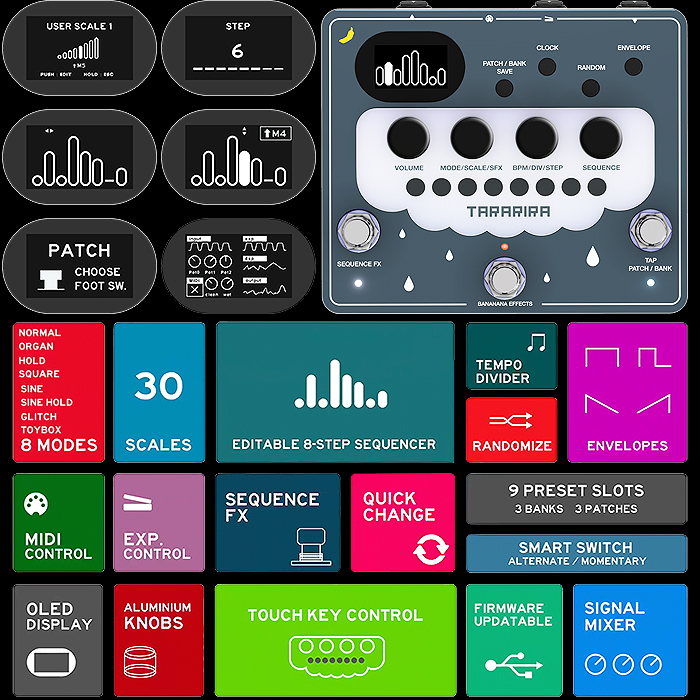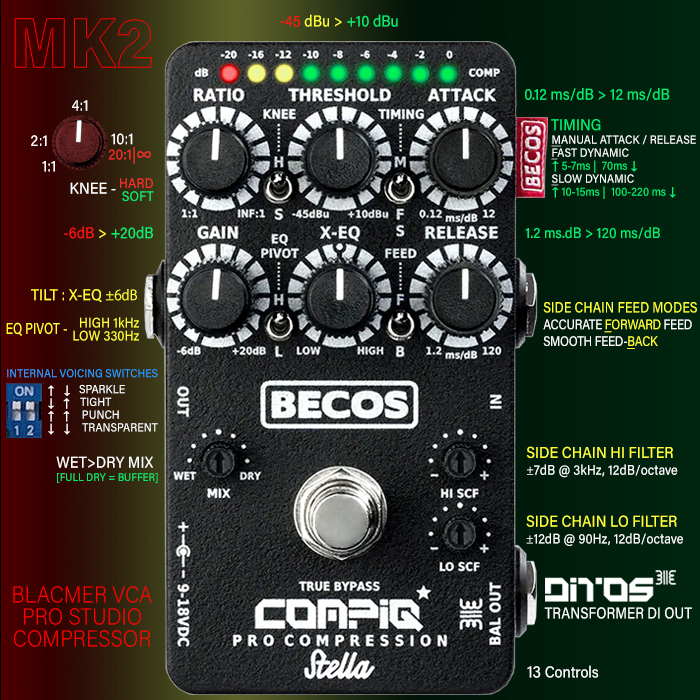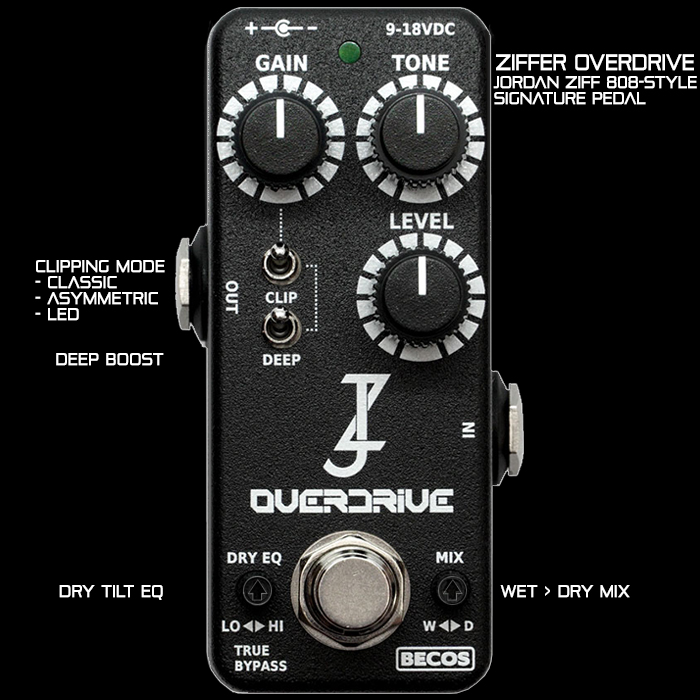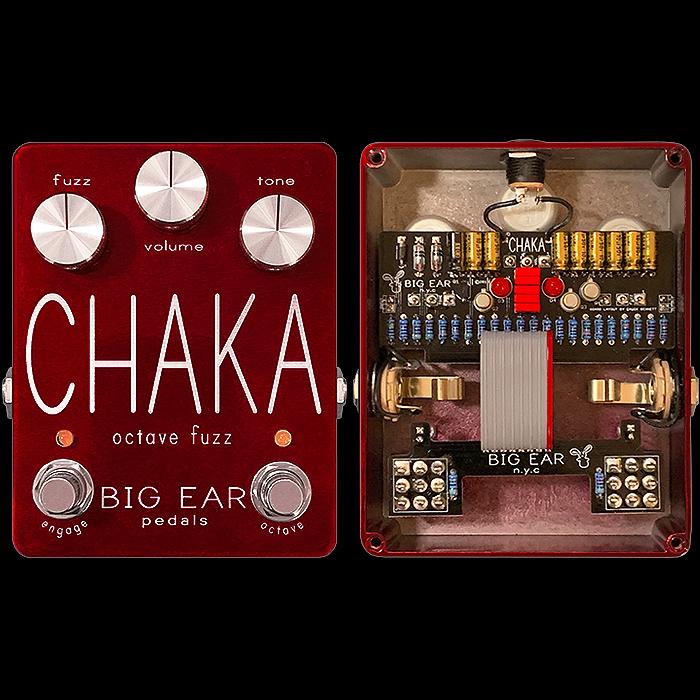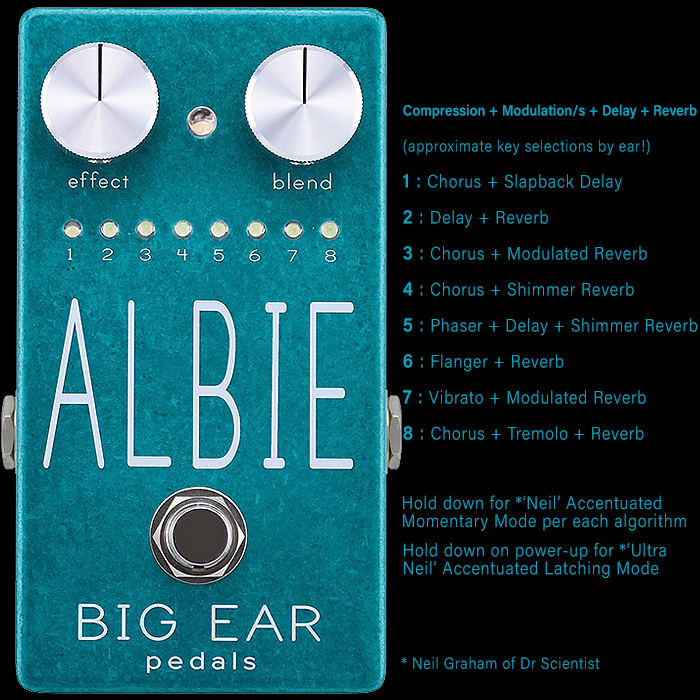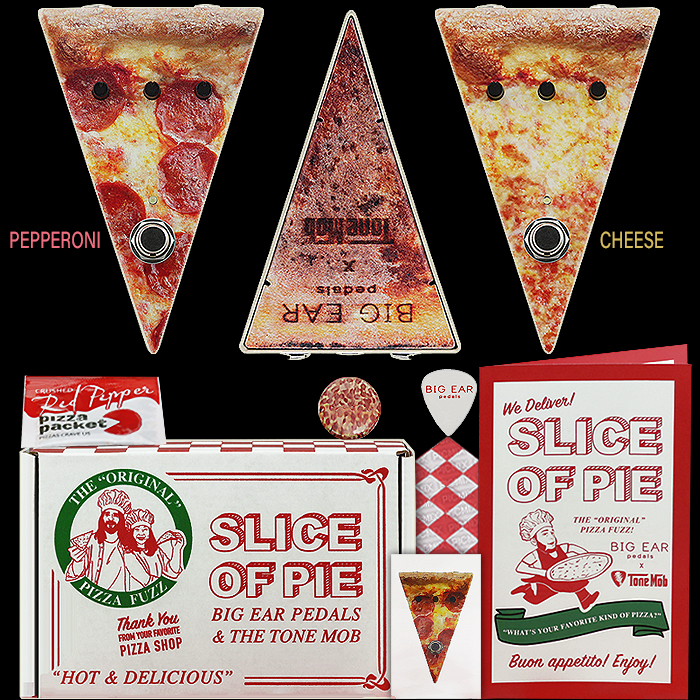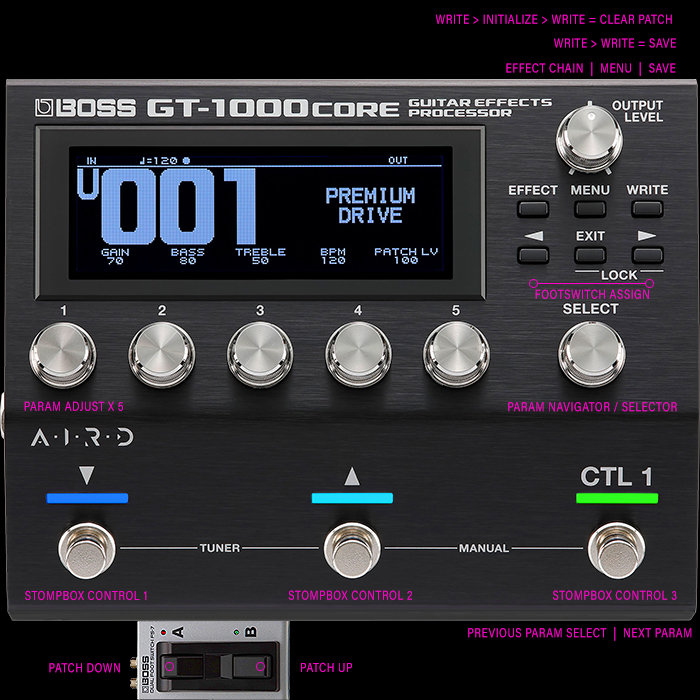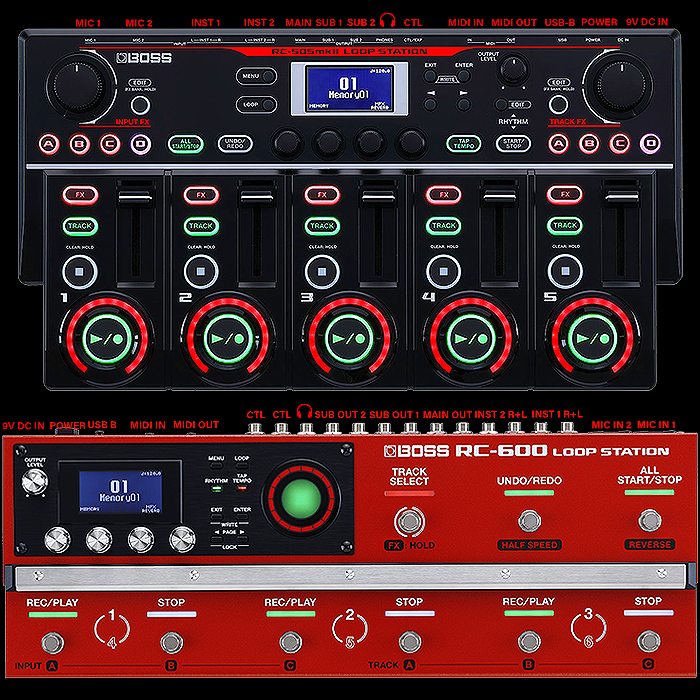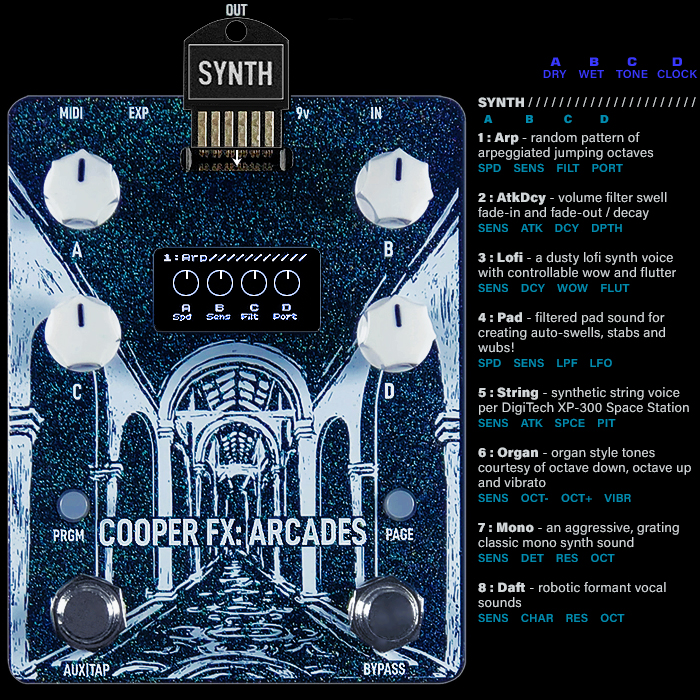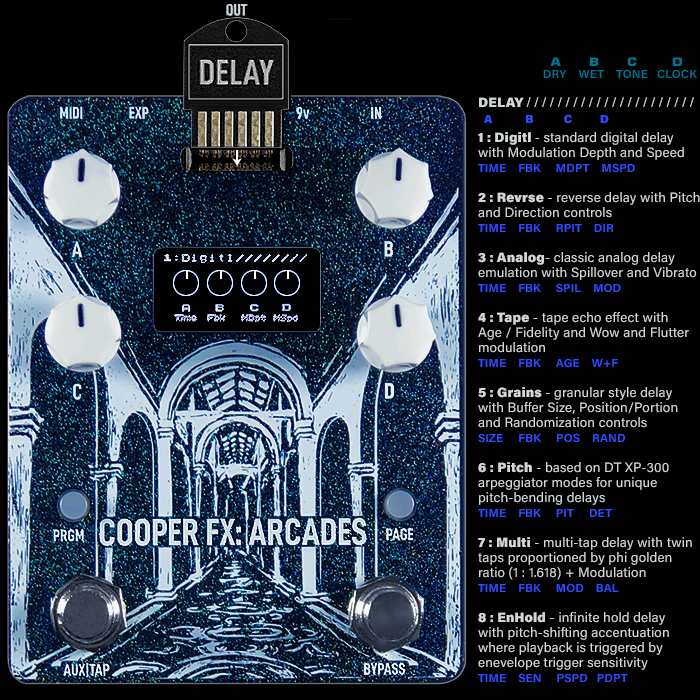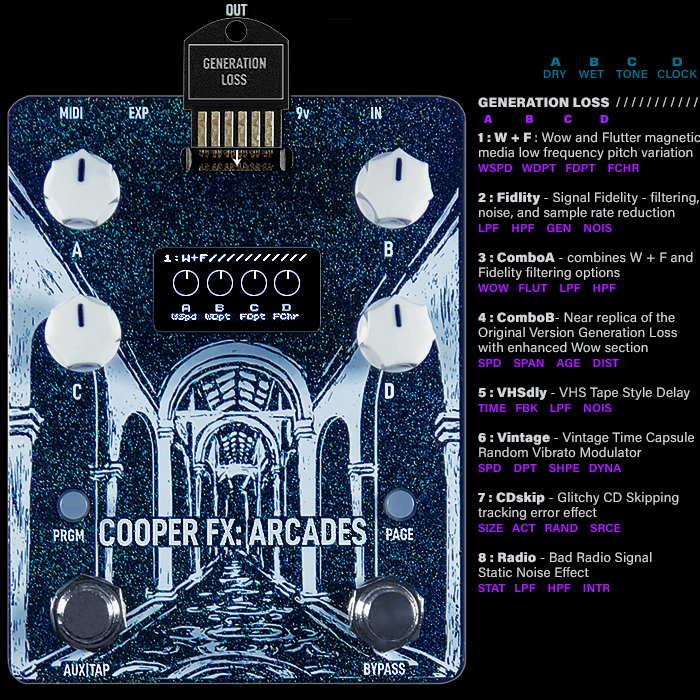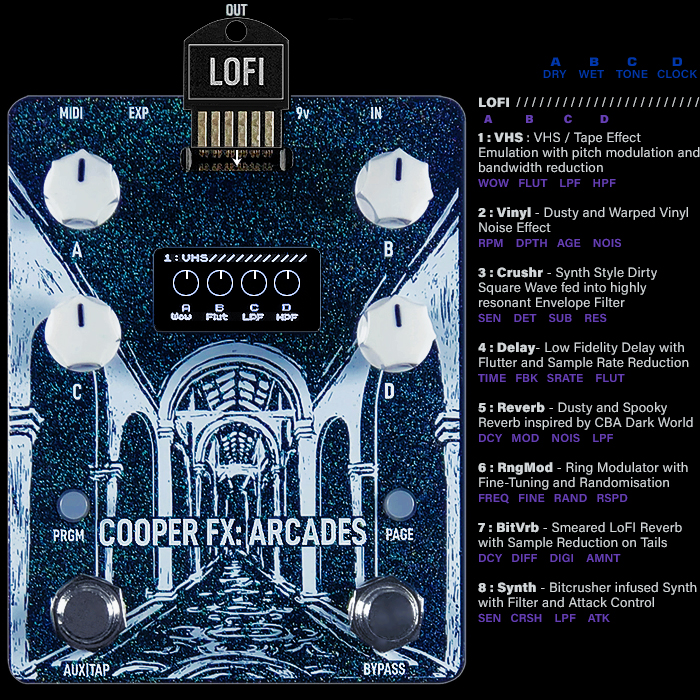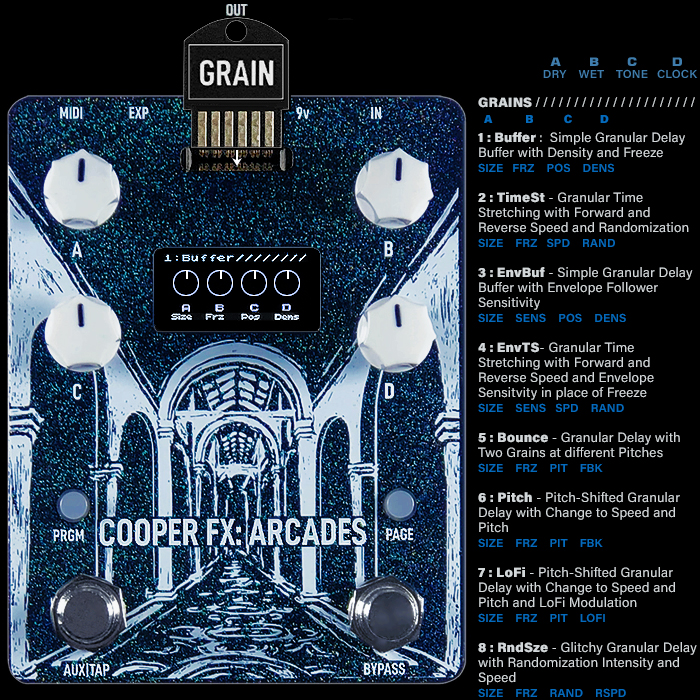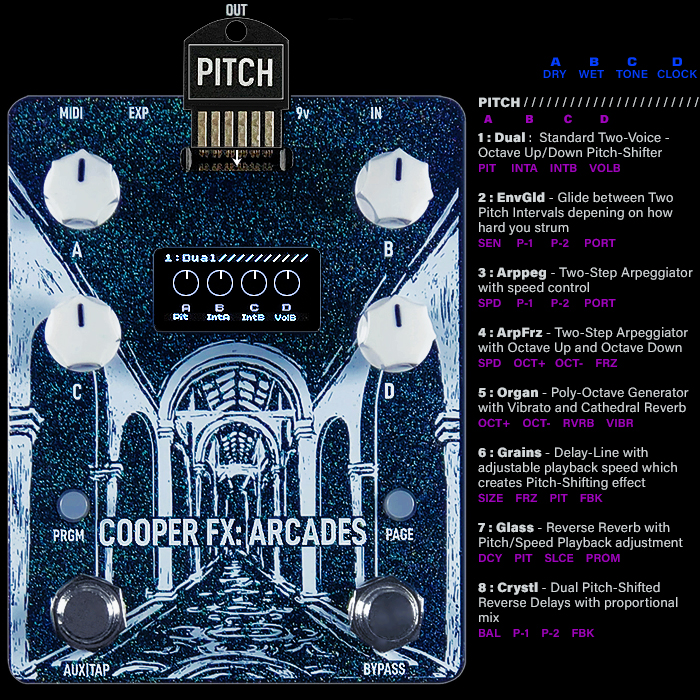2020 Best of New Modulation, Pitch and Utility Pedals for the Year
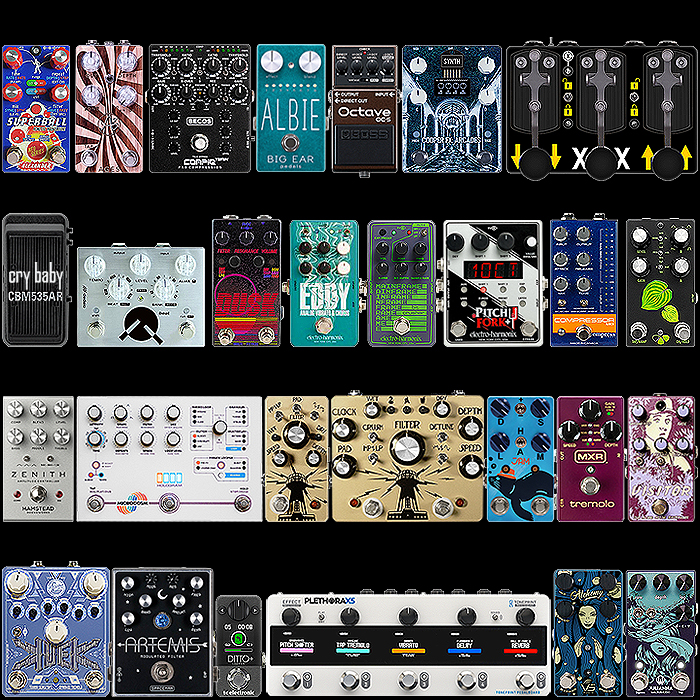
This is the fourth of the preliminary roundups - before I reveal the 25 or so ’Best of the Best of 2020’ - it covers most other pedal genres not yet feature - including in particularly modulation and utility types. Note though that there will be a couple more surprises in the final reckoning!
Unlike the Delay and Reverb category I actually own a few of these, while other outstanding ones are very high on the priority list for next year.
I own 7 of these all-told - the Anasounds Ages Harmonic Tremolo, Big Ear Albie Multi-FX Ambient Modulator, Boss OC-5 Octave, Cooper FX Arcades (various Cards), Dr Scientist Dusk Dynamic Filter, JAM Pedals Harmonious Monk Harmonic Tremolo (ordered from Andertons), and VS Audio Alchemy Analog Chorus with Presets.
Those here that are high priority acquisition targets for next year include the following 7 :
- CopperSound Triplegraph (likely coming to Andertons)
- CryBaby CBM535AR Auto Return Wah
- Flower Pedals Hosta Analog Wah Filter
- Hungry Robot Wardenclyffe V2 Compact Lo-Fi Modulator
- Spaceman Effects Artemis Variable-State Modulated Filter
- TC Electronic Ditto+ Mini Looper
- Walrus Audio Julianna Deluxe Stereo Chorus
The Triplegraph is suitably top of that list and is probably the one that I want the most!
Commpared to the plethora of Overdrive, Distortion, Fuzz and Reverb Workstation Pedals in particular - there aren’t really any major patterns here. There are a few Tremolos for sure and a few chorusing style effects - but not sufficient numbers to call it a trend.
There are some truly fantastically innovative smart pedals here - which show how this format keeps evolving and moving along. I’d still like to see more here with footswitchable onboard presets - like how the Chase Bliss Audio Automatone Preamp MKII operates, and ended the VS Audio Alchemy to fairly similar extent.
It’s also heartening to see Old Blood Noise Endeavor’s Visitor Parallel Modulator - I expected to see more of that ilk this year - but am glad we’re at least starting to move in that direction.
There’s also that constant inquiry into practicalities and pedalboard friendliness - with can rather discount some pedals - while others arbitrarily get a pass - that is largely based on exactly how and where they are going to be deployed. For instance I love nearly everything about the Hologram Microcosm - but it’s too big and clunk to go in my chain. My pedal of choice there is the fantastic Cooper FX Arcades for a variety of reasons - not least its relatively compact form factor and intuitive control interface, but also its infinite expandability - it’s much easier just to snap in a new flavour of Card with 8 new algorithms than having to chop and change actual pedals, And while the Arcades doesn’t yet cover everything that the Microcosm delivers yet - it certainly has the potential to do so. We should see at least a few cards added every 6 months or so, and surely some brand collaborations along the way - I’ve suggested Pladask Elektronisk, but surely we can include Hologram Electronics too.
The Deluxe Wardenclyffe is amazing - but another that is slightly over-large for me, which is why I’m going for the compact variety. And finally in terms of the CopperSound Triplegraph that will be used slightly outside the chain - or more accurately speaking - to the right of the Preamp MKII - I can then keep all the other elements in the chain. Otherwise I’m sacrificing a few slots at the start of the chain - that really depends on how much use I find for the Triplegraph and how permanent it becomes in the setup - we shall see how that evolves next year - I’m going to have totally re-originate my visual templates to accommodate that properly - and I’m not sure I will picture it in relative ratio - as it might take up to much space on the visual too!
In any case pedals are listed alphabetically by brand as usual, do let me know if I overlooked anything within relevant categories :
Alexander Superball Kinetic Modulator - $199/£199
The Superball is a fairly unique modulator - based on the pattern and dynamics of a bouncing ball. It's another NEO Series pedal with onboard presets, secondary parameters and tap-tempo.
The four key controls - primary and secondary are Time|Rate, Repeat|Depth/Step, Mix|Sync, and Filter|Wave/Pattern - note that some of the secondary parameters vary by algorithm / mode.
The 4 modes are :
- Lo : control LFO paramters at its Low point
- Hi : control LFO parameters when the LFO is at Max
- LFO : controls change LFO speed, depth, wave shape, and tap sync or bounce
- SEQ : controls change the sequencer rate, pattern, steps, and tap sync
This is an interesting and suitably quirky modulator if you're looking for something a little bit different - its not really one of those really weird ones, but it's plenty wonderful nonetheless!
Anasounds Ages Analog Harmonic Touch-Sensitive Tremolo - €249
This has been my Harmonic Tremolo of choice for the year. Part of me is happy that my Harmonious Monk hasn't arrived yet - so to give the Ages a little more time in the spotlight. It's worked out really well for me - and I really like that Envelope Filter Sensitivity that ramps up the Rate or Depth/Intensity and then fades back to the normal level.
There's a lot of features onboard, but getting to the secondary features and parameters is rather more clunky thank I would have liked it - I feel that part could certainly be simplified and made more elegant. The actual Harmonic Tremolo Modulation is not quite as syrupy as I would like - I would want it slightly more touching on Uni-Vibe - which I feel that the Harmonious Monk does pretty well.
That said - this is still a fantastic Harmonic Tremolo even with its secondary features usability flaws.
We have 5 key controls here :
- Out : Level
- R|D : Rate or Depth Sensitivity, middle is just standard Tremolo; secondary feature is Waveforms - Sine/Ramp Down/Ramp Up
- Depth : Intensity of Effect; secondary is Attack Sensitivity Threshold
- Tone : Darkness/Brightness of Effect; secondary is attack vector slow-down/speed-up or less-depth/more-depth
- Tap-Divisions : 2/1 | 4/4 | 1/2 | 1/3 ; secondary feature is Waveforms - Square/Polynomial 'U'/Double Cosine/Triple Cosine
The left footswitch is Tap-Tempo, hold for momentary Max Oscillation, right-hand footswitch is Bypass, hold to access secondary features/functions.
This is a really great Harmonic Tremolo - sound suitably hi-fi and has a great deal of range to it - the dynamic envelope-tracked playback is its real forte - while I think it could do with some extra controls for better ease-of-use.
Becos FX CompiQ TWAIN Dual-Band / Stacked Pro Compression - €299
Becos's flagship Dual-Band / Stacked Compressor is probably the most advanced Studio style compressor out in pedal format. I'm not going to go over all the detail here - you can refer to my earlier feature on the pedal for that. Suffice to say that you have essentially 2 x Stella CompIQ Pro's side-by-side - and with no less than 21 controls.
You can deploy those 2 compressors in various configurations to give you degrees and nuances of compression just not available anywhere else. I would imagine this is the perfect pedal for slide guitar players and studio applications. For me personally it's a little much for how I use compression - the Stella would be more suitable really for most applications.
While the Twain is ideal for advanced Studio scenarios and slide rigs like I mentioned - a quite fantastic pro tool.
Big Ear Pedals Albie Multi-FX 80's Ambient Modulator - $199
I was a little late to Grant and Karen's Big Ear Pedals imprint - and I still need to acquire both Woodcutter and Loaf Fuzzes - pretty much soon as - into the new year.
In the meantime I do have an Albie on order - which should hopefully materialise some time during January.
This is a very simply pedal in most ways, but with some hidden depths.
There's only 2 knobs Effect and Blend. Where Effect moves you though 8 different effects combination presets inspired by classic 80's music - The Cure, The Smiths etc. - obviously a bit of chorusing hear and there, phaser, flanger, delay and reverb. Each combination is a closely guarded secret - with the point being you should just select one of the 8 options and play by feel any way you are inspired.
The Blend knob is actually more powerful than you think - as it enhanced / augments different parts of the effects mix to different degrees - so you get some different tones and textures along that dial.
Also if you hold down the footswitch you can access a secondary mode for each algorithm as programmed by the engineer Neil Graham who usually works with Dr Scientist. Those 'Neil' modes are a further augmentation / enhancement and different mix of the effects - sometimes with further effects added into the mix too.
If you find you prefer the 'Neil' mode algorithms, you can have those as default by holding down the footswitch on powerup.
A huge amount of work has gone into the algorithms of this pedal, and it's a modern masterpiece of creative design. I will probably rotate it in, in place of one of my analog modulations from time to time - every home should have one!
Boss OC-5 Octave - $130/£119
Boss reclaimed its octaving supremacy with its new OC-5 iteration which combines the best of the original analog OC-2 with the best of the OC-3.
The Vintage OC-2 Mode sounds great to me - and that's where I choose to live - weirdly with the input set to Bass!
There are 5 elegant and straightforward controls here - including the OC-2 Vintage and Modern Polyphonic playback Mode selector - then Direct Level, +1 Octave Level, -1 Octave Level, and -2 Octave Level|Range.
For the OC-2 Vintage Mode you get 4 octaves essentially : Dry, +1, -1, and -2, while in the poly mode you loose the -2 Octave as that dial becomes the range selector - which allows you to limit the octave effect to only the lowest string/s / notes.
Some of the Bass players still seem to prefer the original discontinued analog OC-2 editions, while I find that this pedal is pretty much perfect for guitar - and the OC-2 mode in particular sounds fantastic.
Cooper FX Arcades Modular Multi-FX Workstation - $299/£299 + $49/£49 per 8-Mode Module Card
I've shared so much content on this pedal this year - working my way through each of the major release 8 Module Cards - with 5 covered thus far. There's two more cards also in the wild - a very limited collaboration with Ambient Endeavors, and a Pastiche / sort of best of sampler Card.
There are so many reasons to buy / own this pedal - it's relatively compact footprint, its ingenious control interface, onboard presets and configuration, and the infinite expandability courtesy of those rather neat modular Cards.
I do also really like the Hologram Microcosm - but that is somewhat too large for me in size to fit into my pedal-chain. It's control-side is a little more opaque, while it has a solid feature set - it's also not infinitely expandable unlike the Arcades. I've suggested that Tom Majeski can collaborate with Hologram Electronics and Pladask Elektrisk, possibly also Tomkat Pedals - for signature collaboration cards - a la Ambient Endeavors.
And while the Arcades doesn't yet cover everything the Microcosm delivers it likely will eventually, and it already covers a whole lot more! I've hitched my wagon to the Arcades - and I'm in it for the long run - have no doubt that this is a genius pedal all-round!
Coppersound Signature Jack White Triplegraph Dual-Octave, Kill-Switch and FX-Loop Engage - $399
I've been in contact with Co-Founder and Design Director Jordan Collins back a while now - waiting for news of forthcoming batches and dealer contracts. My understanding from certain other sources is that Andertons will be getting these in - sometime in the not too distant future - and I will make sure my name is on that list.
I had been putting off acquisition for this relatively pricey pedal - as I really don't want to pay all the additional customs and import fees - with such an expensive pedal - those costs can run upwards of an additional £150 - which is not too clever a move really.
This is the one really big pedal that got away from me this year as such - as I would have liked to have secured one earlier. It has stood some really intensively robust testing under Jack White's forceful stomp - where he pretty much demolished the earliest examples before they were further fortified and reinforced.
The concept of the pedal could not be simpler - you have 3 stomp-proof telegraph keys which engage, in latched or momentary fashion, octave down, and octave up effects, kill-dry or engage FX Loop. You can stomp on those keys individually or in combination, including all at once.
The only downside really is the size of the unit - which cannot be smaller in order to accommodate those switches, and the pedal's general availability. Up until very recently these were only available from Jack White's Third Man Records Webstore, but they've recently been opened up to dealers - or I should say dealer really as only BS Music Shop thus far has had a handful of units for sale - obviously all snapped up double quick.
So I'm fixing my hopes on Andertons here - who have helped this brother out quite a few times in the past! Hopefully I will have my own unit fairly near the start of the new year.
CryBaby CBM535AR Auto-Return Mini-Wah - $150/£159
This has been on the wishlist for a while and I've just not yet got around to pulling the trigger - I always seem to have other priorities. There has been such a stream of limited edition bun-fights of late which has taken all the focus and energy.
I will definitely have one of these relatively soon - it's pretty much identical to the CBM535Q which I already have - bar for the spring-loaded activate and return mechanism. This doe two great new things - as when it springs back it automatically bypasses the pedal - so you need never start up to a scenario where you have inadvertently left your Wah at half-cock as such - and can't figure out why your signal chain sounds slightly off. You also don't need to engage in all that annoying click nonsense as with the conventional Wahs - in that any movement activates the effect - you let go and the treadle returns to the starting position and switches to bypass as it does.
This solves most of the annoyances I have with manual Wahs, although I will still probably mostly rely on Envelope Filters and Auto-Wahs - over the manual varieties!
While of the manual types - this is easily the best variety for me.
Dedalo FX Beat Drum Machine - AR$13,210/$160
A really unique beat machine pedal by Argentinian pedal builder Dedalo, and as revealed at Winter NAMM - where you tap in the various rhythm components yourself - allowing to you to build up your own patterns via 6 controls and dual footswitches.
A genuinely innovative performance pedal, and one with fairly unfettered potential. I would imagine over time this will evolve into something a little more substantial with different drum set sounds, and more variety in percussion components - over the basic bass drum, snare, hi-hat sort of stuff that it has in its earliest version.
Really innovative though with a huge performance potential.
Dr Scientist Dusk Dynamic Filter - $199/£189
My favourite dynamic filter and current auto wah substitute of choice! This is an ingenious filter confection by Ryan and Tanya of Dr Scientis, and no doubt Neil Graham too. That has lived on slot #4 of my pedal-chain for most of the year.
Right at the top you get 3 control knobs - Digital control of the Analog OTA Filter, then Analog Resonance and Volume controls. Next you have 2 push-buttons accompanied by colour-coded LEDs - the left button sets one of 3 Key Modes :
- CutOff
- Envelope Filter
- Low Frequency Oscillation
While the right-hand button selects up to 6 different sub-modes per Key Mode.
You have dual footswitches - the left-hand one of which engages a specific ramp effect per the algorithm selected, while the right-hand footswitch is the Bypass, and if you hold it down - you get to cycle through 5 user-definable presets.
This is the perfect combination of form-factor, feature set and usability - and it's just as clever as it looks. In some ways the Spaceman Artemis does slightly more width different band filters - yet lacks the presets and essential pizazz of this Dusk unit. The Flower Pedals Hosta Filter / Auto Wah is also pretty decent.
I will likely be getting the Hosta and Artemis too at some stage next year as understudies, while as the smartest of the 3 - the Dusk is likely to hold its place for the main part!
Electro-Harmonix EDDY Vibrato/Chorus with Envelope Filtering - $99/£99
EHX introduces quite a unique Analog Chorus/Vibrato with Envelope Filtering - which is somewhat reminiscent tome of the Paradox Effects Futura. A reader tells me though that they are pretty different and both well worth a hearing as such.
The Eddy has 8 controls all told - with single footswitch : 6 knobs - Volume, Wave Shape, Chorus Rate, Tone, Envelope Rate/Depth, and Chorus Depth. The first toggle switch is the Wet/Dry mode thing or Vibrato/Chorus, while the second footswitch sets the Envelope and Expression Parameter - either Rate or Depth.
Certainly an intriguing proposition and a fantastic price point for analog chorus - looks like I might just have to add this to the collection - as the pricing elevates it above the Futura on the wishlist. While it's not a priority for me - as I still have a lot of other pedals to pin down first.
Electro-Harmonix Mainframe Bitcrusher - $179/£165
This is probably my favourite of the new bitcrushers - and is just after the Catalinbread Heliotrope in my wishlist.
The Mainframe has 8 controls and a 3-Band Filter, with 6 knobs - Volume, Peak, Frequency, Blend, Bit Depth, and Sample Rate, also an Expression/Preset push-button, and the 3 x Filter Bands : HPF/BPF/LPF
This is a great modern bitcrusher like I said and I think most will really like it
Electro-Harmonix Pitch Fork+ Dual-Voiced Polyphonic Pitch-Shifter and Harmonizer - $214/£179
I never yet got around to getting in the original Pitch Fork - while this improves on every aspect of that - bringing 2 individually controllable shifters with much extended range, as well as an alternative 'User' Settings/Mode.
At the top you have 3 knobs - Dry, Shift 1, Shift 2, then the Value-Enter/Save push-button - followed by 8 more option buttons - Aux, Shift 1 On/Off, Shift 2 On/Off, Expression, User, X-Mod, Preset, Latch. Then two footswitches - the User mode and Bypass On/Off switch.
I'm definitely down for adding this to the collection and it will make a great rotation alternative for slot #2 which the OC-5 currently occupies, and where the Meris Hedra is usually the mainstay - each of those offers something different.
Empress Effects Compressor MKII - $249/£249
The Empress Compressor has always been a great candidate for that type / category - while its former BB-size form factor stood in the way of universal pedalboard friendliness.
Just as well then that Empress has shrunken down its classic pedal into compact enclosure - while retaining every function of the original. 6-knobs and 2 x toggle-switches - Input, Output, Attack, Release, Mix, SideChain High Pass Filter, Ratio - 2:1|4:1|10:1, and Tone/Colour - Mid Scoop | Off | Mid Boost.
I already have several preferences for compressor, and am not about to shift my Jackson Audio Bloom, but I certainly recognise the quality here.
Flower Pedals Hosta Analog Wah Filter - $279
This is my second equal favourite of the new filter pedals this year - alongside the Spaceman Artemis, and with the Dr Scientist Dusk just slightly in the lead.
It sports 7 dynamic and variable controls with dual footswitches - Level, Mode - Auto/Fixed/Envelope, B/Wave Shape, Frequency - Treble/Mids/Bass, Gain, Q - High/Med/Low, A/Speed/Filter Cutoff/Threshold.
And while the Dr Scientist Dusk will likely still be my principal, I will though almost definitely be acquiring both this Hosta and the Spaceman Artemis in 2021 - I just need to decide in which order of priority.
Hamstead Soundworks Zenith Amplitude Controller Clean Boost + EQ + Compressor - $349/£379
Hamstead's latest offering which took a while to materialise after being teased at NAMM - is billed as the Ultimate Tone Shaper.
Foremost here are the various EQ settings - including 3-Band EQ with Parametric Mids and Q-Control. Then Compressor, Blend and Level controls. Also on the rear of the pedal you can switch between C>EQ or EQ>C.
The Zenith has a great feature set, but is all-round not quite as smart a solution as the Jackson Audio Bloom - while obviously the Zenith has more EQ options, and the Bloom has more Compression options. The really smart thing about the Bloom is the use of its two footswitches - with which you can individually switch in and out Compressor, EQ and Boost effects.
The Zenith is very much a super high quality combination effect which leans slightly more towards the EQ side of things. Lots of players should love what it brings all in the one pedal.
Hologram Electronics Microcosm Granular Synthesis Multi-FX - $449
At the time of its launch, I called this the most mature and feature-rich Granular Synthesis Pedal to date.
It comes with 16 onboard User Presets, 11 distinct effects with 4 variations for a total of 44 unique granular presets. 9 knobs - Activity, Wave Shape | Mod Freq, Filter | Resonance, Mix | Effect Volume, Time, Repeats | Mod Depth, Space | Reverb Time, Loop Level | Fade Time, Mode - 3 x Micro Loop, 3 x Granules, 3 x Glitch, 2 x MultiDelay.
The two push-buttons are for Sub Division / Tempo, and Phrase Looper. With 3 footswitches including Tap-Tempo, Looper Functions and Momentary Effects.
Just a fantastic combination of features that produces something really unique. If this device was a little smaller I would likely have snapped it up by now.
Hungry Robot Wardenclyffe V2 Compact Lo-Fi Ambient Modulator - $197
No official demos yet for the new Wardenclyffe editions - so the old one has to suffice (as above).
Great engineering feat again in miniaturising the former BB-size pedal and retaining all the features in the smaller format - most definitely the right size now for me.
The features / functions / controls as before are - Wet, Dry, Filter, Speed and Depth knobs of various sizes, then 3 x toggle switches - HP/LP, Pad On/Off, and LFO/Glitch Mode.
A great lo-fi warbly modulator, now in fully pedalboard-friendly enclosure. I will most likely be getting in this edition eventually.
Hungry Robot Wardenclyffe Deluxe Lo-Fi Ambient Modulator - $297
The Deluxe editions adds a whole new slew of features - 3 x Vinyl Effects - Hiss, Crackle and Pop, a new Clock Rate knob, Crush switch, Detune switch, variable Pad knob, and a second Tap-Tempo footswitch and LFO Rate LED.
The Deluxe Wardenclyffe is obviously the ultimate Lo-Fi Modulator with all those added features and effects - it does though cover at least 3 times as much real estate as the Compact V2.
I really like what the Deluxe does, but I just can't fit it into my rig without sacrificing a whole load of essential pedals. Which is why I will rather be making do with the new more Compact V2 edition.
If you can accommodate the size of the Deluxe - I highly recommend you try one out.
Note - no demos available as yet.
JAM Pedals + That Pedal Show Harmonious Monk Harmonic Tremolo - €249/£229
I was actually really excited about this pedal when Mick and Dan teased it on their show. I'm obviously a big fan of Harmonic Tremolo, and I'm particularly enamoured with those which run a little more syrupy and touch more on Uni-Vibe sort of modulation - as in fact the Harmonious Monk does very admirably.
When I first saw / heard the pedal I presumed the second footswitch was for Tap-Tempo, but it's a Speed doubler - i.e. 2 x whatever is set on the top-right Speed dial. Controls are Depth, Intense/Subtle switch, Speed, Level, Harmonic/Amplitude Mode, and Mix.
It sounds tremendous and yes it gets suitably syrupy when cranked. This means I can roughly cover both a pseudo Uni-Vibe and Tremolo style effect, in the one modulation pedal. This will be my 3rd harmonic tremolo after the CBA Gravitas, and Anasounds Ages.
I have one on order with Andertons - and I'm expecting delivery some time in January as far as I'm aware.
MXR M305 6-voice Tremolo - $160/£175
I'm assuming there's some sort of DSP or chip involved here to render those 6 flavours of Tremolo :
- MXR : Classic M159 Tremolo
- BIAS : Vintage Bias Waveform
- REVO : Reverse Optical Waveform
- OPTO : Optical Waveform
- SQR : Square Waveform
- HARM : Vintage Harmonic Tremolo
You get just 3 controls here - Gain (push to cycle Modes), Speed, and Depth. I would have liked to have seen a second tap-tempo footswitch here. Regardless of that this is still a very versatile proposition, albeit it doesn't quite find its way onto my own wishlist as I have numerous other preferences in this category already.
Old Blood Noise Endeavors Visitor Parallel Multi-Modulator Pedal - $199/£199
A fascinating Parallel Multi-Modulator which I thought would trigger a spate of similar parallel combination pedals this year - yet this remains the only one to-date.
You get 5 knobs here - Secondary Modulation Control, Rate, Mix, Regen, and Depth.
You also get Primary and Secondary Modulation Mode switches. The Primary Modes are Tremolo, Chorus and Phaser, and the Secondary Modes are Tremolo and Chorus.
The GFI Synesthesia does this sort of thing very well with a lot more modes and options. My Boss GT-1000 CORE also is very capable of mixing up to 3 modulation effects in parallel. Or more accurately - the ability to create 3 parallel paths, each with its modulation of choice.
So the OBNE Visitor is really decent, and particularly in its Compact enclosure - while I already have similar capabilities which are Stereo to boot!
Rock Fabrik Effects Kuek Touch Sensitive Dynamic Tremolo - €179
This is actually the tremolo which encouraged me to get the Anasounds Ages - as I really liked the Kueks's Touch-Responsiveness, but really wanted that sort of effect in a more compact pedal.
Because all the Kuek controls are fully surfaced - you get a somewhat easier access to the full range of parameters.
Its 10 controls are :
- Duty Cycle : Fraction of period in which the signal is active
- Depth
- Speed
- Way : Ending Value of Dynamic Speed
- Waveform : Sawtooth/Square/Triangle/Sine/Rectified Sine
- Decay
- Raid : Rise / Ramp time
- Touch : Touch Sensitivity
- Volume
- Tap Division : x1/x2/x3
It also has dual footswitches, the left of which is Tap-Tempo.
This is a terrific tremolo, but it's a little large for my needs, and doesn't have my essential favourite Harmonic Tremolo flavour either - but a fantastic feature-rich format nonetheless.
Spaceman Effects Artemis Variable-State Modulated Filter - $299/£299
SpiralCaster Cohen Hartman's demo of this pedal totally sold me on first viewing. Even though it's a more manual affair than the Dr Scientist Dusk - and not so user-friendly as such - it does though have some extraordinary musical abilities as Cohen proves with ease.
The 8 knobs - 6 regular, and 2 minis, render the following functions :
- High - High Pass Filter
- Band - Band Pass Filter
- Low - Low Pass Filter
- Res - Filter Resonance
- Modes, along with variable Amount, Sensitivity and Frequency knob functions :
- 08:00 o’c - Envelope Up | Amount = Mod Depth | Sens = Picking Dynamic Sensitivity | Freq = Start point of sweep
- 09:15 o’c - Envelop Down | Amount = Mode Depth | Sens = Picking Dynamic Sensitivity | Freq = End point of sweep
- 10:30 o’c - LFO Triangle Wave | Amount = Mod Speed | Sens = Dynamic LFO Speed Modulation | Freq = Start point of sweep
- 12:00 o’c - LFO Ramp Up Wave | Amount = Mod Speed | Sens = Dynamic LFO Speed Modulation | Freq = Start point of sweep
- 01:30 o’c - LFO Ramp Down Wave | Amount = Mod Speed | Sens = Dynamic LFO Speed Modulation | Freq = Start point of sweep
- 02:45 o’c - LFO Random Wave | Amount = Mod Speed | Sens = Dynamic LFO Speed Modulation | Freq = Start point of sweep
- 04:00 o’c - Static | Amount = Disconnected | Sens = Disconnected | Freq = Manual Sweep
The Artemis is a little larger than I would have liked it, but I've already determined I will probably get it - just depends which I get first - this or the Flower Pedals Hosta. Both would act as rotation understudies to the Dr Scientist Dust - which remains my principal filter pedal of choice.
TC Electonics Ditto+ Mini Looper - $129/£109
TC Electronic recaptures its Mini Looper Supremacy with the more visual and more intuitive '+' version of its world-conquering Mini Ditto Looper. Now you can record up to 99 loops, with a total maximum recording time of 60 minutes. You also get improved controls and a brand new highly impactful and user-friendly colourful and colour-coded LED screen which displays the key functions of Record, Play, Overdub, Undo, Redo, Pause, and Delete.
I meant to snag one of these earlier as it's something every player should have. I typically use my smaller Ditto at the front of my chain for repeating loops going into the chain - versus the Stereo Boss RC10-R which sits at the end of the chain.
It's one of my priorities for next year.
TC Electronic Plethora X5 TonePrint Pedalboard Multi-FX Unit - $450/£399
It seems I rather prematurely already ascribed all the TCE TonePrint pedals to the Plethora, while the Helix Phaser and Viscous Vibe have only very recently been added into the mix - courtesy of the December 18th 1.2 Firmware Release. You also get a Ditto-like 80 second Mono / 40 second Stereo Tape Deck Looper, and the ability to assign 'Hot Knobz' or any parameter to any of those knob controls. You also get 9 new Cab Sims, dual footswitch control for preset up/down for instance, and you get extended Midi Control.
The essence of this pedal is that you can deploy any of TC Electronic's TonePrint Pedal Algorithms simultaneously in groups of 5 - each with MASH enabled footswitch and individual Tweak control.
You can save 127 presets of those 5 Algorithm boards - or in essence 127 mini boards.
For TC Electronic fans this is a great way to get everything they offer in terms of TonePrint pedals in the one box, but it is rather large on the footprint side, and somewhat more limited than say a Boss GT-1000 CORE or Line 6 Helix HX Stomp.
I still feel this would be the perfect pedal for many players - but its size dictates that you need to shape your rig around it really.
VS Audio Alchemy BBD Analog Chorus with Presets - €249
Quite simply my favourite Chorus to date - a proper BBD Analog Chorus with 4 smart controls - Mix, Delay, Speed and Depth, and with 6 user-definable presets instantly selectable on the right-hand footswitch.
I typically like a second tap-tempo footswitch, but since you have 7 different settings at your disposal - the 6 Presets and then the active panel settings - you don't really miss that lack of dynamic speed control - as you can set up all the settings you need in advance.
The Delay control adds a phasey element to the Chorus - meaning you also get into sort of DC-2/W sounds / territory - perfect for getting your Prince Purple Rain on.
The Alchemy has been huge for me this year - I've used is for pretty much everything and during every jamming session. Highly recommended!
Walrus Audio Julianna Deluxe Chorus - $249/£225
This is the Walrus Audio Julia I always wanted - with extra Tap-Tempo footswitch and Tap-Divisions. It also has a new 3rd Random stepped waveform mode, full Stereo Ins and Outs, a new secondary Drift Feature, and new secondary Momentary LFO Rate change.
All the existing Julia functionality is still in place, admittedly this Deluxe version costs a little more, but it's well worth the extra for me - particularly for the Tap-Tempo, Stereo and those 2 new dynamic secondary mode features.
There's obviously a lot of great choruses out there now - but I think I will for the main part be sticking with my VS Audio Alchemy for now. While the Walrus Audio Julias is now on my wishlist too - as a possibly occasional rotation understudy / alternative.
Final Thoughts
Well - that was all somewhat exhausting - these near 30 pedal overviews really do take it out of you - and take a very considerable time to research, compile and write up.
I am satisfied though that I covered most of the more innovative pedals releases this year - and I'm always delighted to see onward development and evolution of these inspiration boxes. There are so many different highlights here - and people need to be aware that the criteria include innovation, practicality and ease of use as well as output quality. I think I'm pretty satisfied with this overall selection - and hopefully I have managed to include a number of your favourites here - apologies if I've missed any out - do let me know.
As reported here - there are quite a number of these on my wishlist / acquisition list - but as always we need to wait and see how that tallies with other rising priorities - and I already know of a number of pedal launches that were postponed to early next year - so there's going to be a lot of new talent about.
I still feel I'm pretty well covered, and any updates on my pedalboard slots aren't always incremental improvements - rather just subtle shifts in flavour. So we'll see how all that pans out in 2021.
There are a few here though that I should definitely have this year whatever happens - and that would be the Triplegraph, CryBaby CMX535AR, and Ditto+ in particular. I'm also pretty keen on the Flower Pedals Hosta, Hungry Robot Wardenclyffe V2 Compact, and Spaceman Artemis.
As always I won't get everything on my list - certainly not all in the same year - some will inevitably trickle forward again - but it's exciting that there are still plenty of inspirational pedals out there.



















